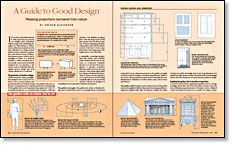All About Furniture Design

If you aren’t following a set of commercial plans to build a piece of furniture, then most likely you will encounter the design process. Don’t be afraid — following a few basic principles and trusting your intuition will take you far.
The Basics:
• Devise a plan: Follow a measured drawing or a computer-generated blueprint.
• Consider form, function, and joinery: A design may look good on paper but lack basic strength and stability.
• When it doubt, mock it up: Full size or to scale, seeing a piece in three dimensions will solve many issues early on.
Devise a plan
Building furniture without plans is not unheard of, but it is not advised. It’s best to go into a project with a plan to follow. This will help you purchase the right amount of lumber, and it will help you head off many issues early in the process. A design can start out as a sketch on a napkin, but eventually it must be translated into something that can be used to create measured pieces.
There are several methods to go about this. SketchUp and other computer-aided design (CAD) programs are increasingly popular among hobbyists and professionals for designing furniture. These programs are available in a range of prices, from less than $100 for consumer desktop software to thousands of dollars for industrial-grade applications. As desktop computers get faster and stronger, so do the consumer software applications. Many can render designs in 3D or color parts with wood grain. If you are averse to CAD programs, there is always the pencil-and-paper approach.
Consider form, function, and joinery
Coming up with a design that looks nice is only part of the process. Ensuring strength and stability is the other. When designing a custom piece of furniture it is essential that you choose joinery that is strong enough to support the intended use. For example, a chair built with weak seat-to-leg joinery is probably not something you want to sit on. Consider the function of a piece, and make sure that the design accommodates it.
Furniture design may also follow a basic set of principles, such as the golden ratio, a naturally occurring mathematical formula that has been used to design everything from the Parthenon to the highboy. While these formulas can get you started, they don’t have to be the guiding force in the design process.
When in doubt, mock it up
It is sometimes hard to truly understand a piece of furniture from a drawing. Even a three-quarter view doesn’t tell the whole story. Mockups, whether full size or to scale, can be a wonderful visual aid to help you refine a design.
Fine Woodworking Recommended Products

Drafting Tools

Dividers

Compass























Log in or create an account to post a comment.
Sign up Log in